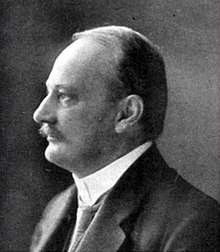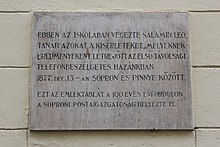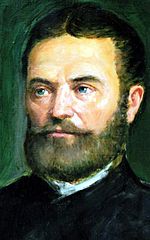László Rátz
László Rátz (9 April 1863 in Sopron – 30 September 1930 in Budapest) was a Hungarian mathematics high school teacher best known for educating such people as John von Neumann and Nobel laureate Eugene Wigner.
His father, Ágost Rátz, was a hardware merchant and ironmonger, and his mother was Emma Töpler of Danube Swabian origin.
He worked as a practicing teacher in the Main Practising Secondary School of Budapest Science University from September 1889.
From 1890 he was a mathematics professor at the "Budapest-Fasori Evangélikus Gimnázium", a German-speaking Lutheran High School in Városligeti fasor 17–21 in Budapest.
Although his father insisted he attend school at the grade level appropriate to his age, he agreed to hire private tutors to give him advanced instruction in those areas in which he had displayed an aptitude.
An embossed marble tablet commemorates him on the wall of Budapest Lutheran Gymnasium, Budapest-Fasori Evangélikus Gimnázium.
[2] The archives of the High School Mathematics and Physics Journal, known as KöMaL, a popular abbreviation of the Hungarian name "Középiskolai Matematikai és Fizikai Lapok", is a Hungarian mathematics and physics journal for high school students, which has been continually published since 1894.
The journal has an extraordinary collection of problems and articles, spanning more than a century and representing a significant factor in the history of Hungarian mathematics and physics.
He edited the journal until 1896, when László Rátz, at that time already was a prominent teacher of the Fasori Lutheran High School, took it over from him and continued till 1914.
Some of the Presidents of the Society were György Hajós (1963–1972), László Fejes Tóth (1972–1975), Pál Turán (1975–1976) and János Surányi (1976–1980), the names of some of them are below under Középiskolai Matematikai és Fizikai Lapok, KöMaL.
Some of the best contestants were The reform committee of mathematics declared at the Meran general assembly of nature examiners in Germany in 1905 that sciences also represent cultural values, not only practical benefits: therefore, they are worth being considered equal to linguistics as means of education.
In 1906 the Mathematics Reform Committee was established in Hungary, the chairperson of which was Manó Beke, its secretary was Sándor Mikola and the members included László Rátz as well.
László Rátz and Sándor Mikola, as they found the changes necessary, had worked out the workable methods and curriculum of mathematics teaching.
Finally, their brave initiatives were successful: in November 1909 Rátz and Mikola were officially permitted to teach mathematics in the Lutheran Gymnasium as they found it desirable in accordance with the reform endeavours.
[9] From the beginning he was an active participant in a worldwide effort of science and mathematics teaching education reform; from 1909 he gets official full liberty in improving educational methods in his own high school; he becomes Officier d'Académie award at a 1910 Paris congress.
According to the objectives, mathematics has important involuntarily acquirable subconscious elements that need to be enhanced in students.
The teachers strived to deliver clearly articulated concepts at the voluntary, conscious level, but more importantly, learning of mathematics has to be tightly woven together with direct experience and practice, emphasizing mental calculations and practicing estimations, allowing students to acquire a subconscious knowledge of reality from experience with quantitative relations.








